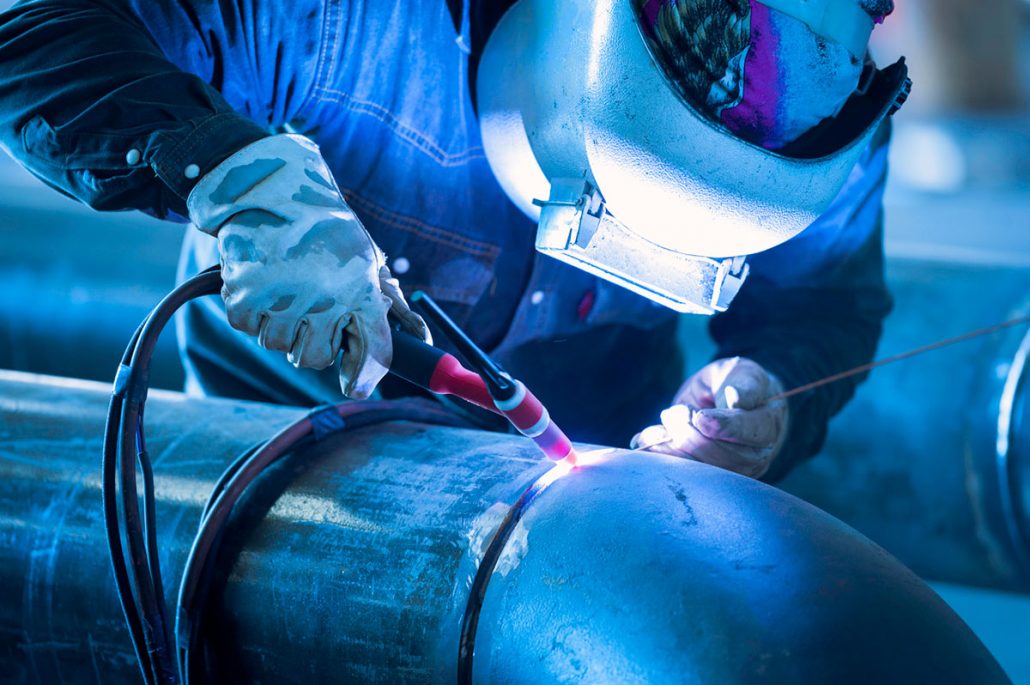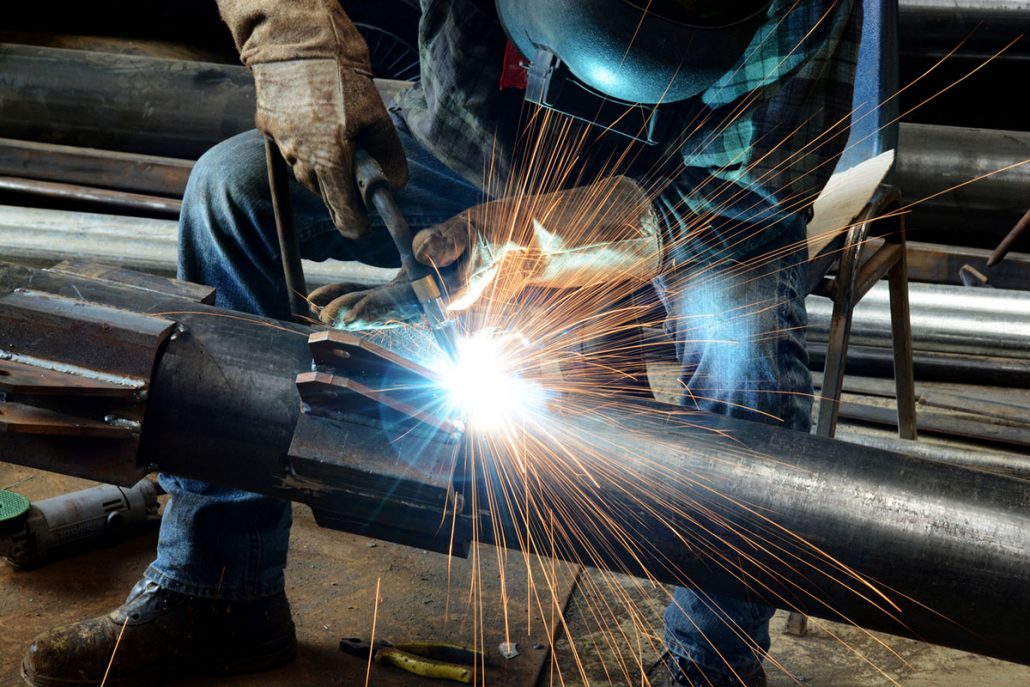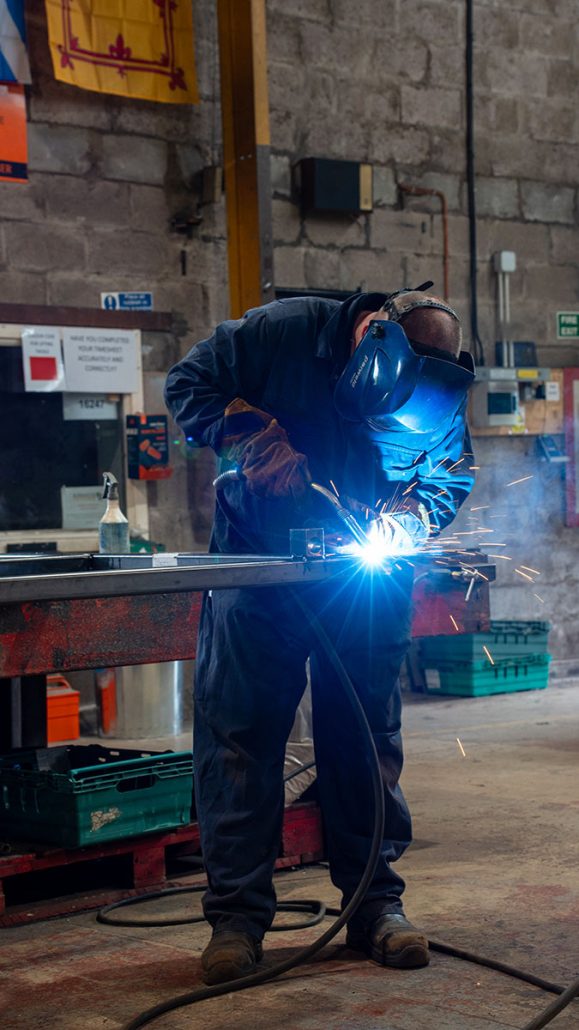Why Welding Method Matters
Choosing the correct welding process directly impacts cost, quality, and long-term durability. Two of the most widely used arc welding techniques are MIG welding (Metal Inert Gas) and TIG welding (Tungsten Inert Gas). Each process has unique advantages depending on the material, application, and industry environment. We’re exploring the differences between MIG and TIG welding, comparing their strengths, and outlining where each method excels so you can make an informed decision for your project.

What Is MIG Welding? (Metal Inert Gas)
MIG welding uses a consumable wire electrode that is continuously fed through a welding gun. The wire melts into the weld pool, joining the materials together. Shielding gas protects the weld from contamination.
This process is known for its speed and efficiency, making it ideal for high-volume or large-scale work such as construction, automotive manufacturing, and general fabrication. MIG welding is versatile, working with mild steel, stainless steel, aluminium, and nickel alloys when paired with the right wire and shielding gas combination.
MIG welding has several clear advantages. The continuous wire feed allows for high productivity and fast deposition rates, and the setup costs are typically lower than other welding methods. It is also easier to learn, which reduces training time and cost. However, MIG is less precise compared to TIG. It is not well-suited for thin materials due to the higher heat input, and it often produces spatter that requires additional cleaning and finishing.
What Is TIG Welding? (Tungsten Inert Gas)
TIG welding uses a non-consumable tungsten electrode to produce the arc. A separate filler rod may be added to create the weld pool, while shielding gas protects the joint from contamination. This process is slower than MIG but offers greater precision and control.
TIG welding produces exceptionally clean, high-quality welds with minimal spatter, making it the preferred choice for industries where weld appearance, hygiene, and integrity are paramount. It is commonly used in pharmaceutical cleanrooms, aerospace, food processing, and stainless steel fabrication.
The advantages of TIG welding are clear: it provides superior precision, clean finishes with minimal post-processing, and is highly suitable for thin metals and exotic alloys. The downsides are its slower speed, higher costs due to equipment and skilled labour, and the requirement for controlled, clean environments.
TIG vs MIG Welding: A Side-by-Side Comparison
| Feature | MIG Welding | TIG Welding |
| Speed | Fast, high deposition rate | Slower, precision-focused |
| Ease of Use | Easier to learn | Requires a skilled operator |
| Material Thickness | Best for medium to thick metals | Best for thin materials and exotic alloys |
| Finish | Some spatter, may require cleaning | Very clean, minimal post-processing |
| Best For | Structural steel, automotive, construction | Stainless steel, pharma, aerospace, architectural |

Which Welding Process Is Best for Your Industry?
Different industries demand different welding outcomes, which makes choosing the right process critical.
- Pharmaceutical / Cleanroom: TIG welding delivers ultra-clean, sanitary welds that meet hygiene and compliance standards.
- Construction & Structural Steel: MIG welding offers fast, economical, and durable results for large-scale frameworks.
- Aerospace / Automotive: Both processes are used: TIG for detailed precision and MIG for high-strength structural assemblies.
- Architectural Fabrication: TIG welding provides the clean appearance and finer finish needed for visible structural elements and decorative components.
When comparing TIG vs MIG welding, there is no single “best” process. The right choice depends on the material, application, and performance requirements of your project. MIG welding excels in speed and cost-efficiency for structural steel and construction, while TIG welding delivers the precision, cleanliness, and quality needed for high-spec industries like pharma, aerospace, and architectural fabrication.

Cost Considerations: TIG vs MIG Welding
Cost is often a deciding factor when selecting a welding method. MIG welding is generally cheaper due to its speed, lower labour costs, and less demanding training requirements. The faster deposition rate makes it well-suited for high-volume production and large-scale builds.
TIG welding, on the other hand, can be more expensive. The process is slower, requires skilled operators, and uses more advanced equipment. However, the total cost of ownership may favour TIG welding when quality, compliance, or aesthetics are critical. In industries such as pharmaceuticals or architecture, the investment pays off in reduced rework, compliance assurance, and long-term performance.
How Burnhouse Engineering Can Help You Choose the Right Process
At Burnhouse Engineering, we provide both TIG and MIG welding services in-house, supported by over 30 years of expertise in fabrication and welding. Our experienced welders and fabricators advise on the best method based on your materials, specifications, and industry standards.
From high-productivity MIG projects in construction to high-purity TIG installations in pharmaceutical facilities, we ensure every weld meets the highest benchmarks for quality, safety, and compliance.
Partnering with Burnhouse means gaining access to:
- Certified welders with specialist expertise
- Full-service fabrication capabilities
- End-to-end project support from consultation to final inspection
At Burnhouse Engineering, we have the expertise and flexibility to deliver both.
